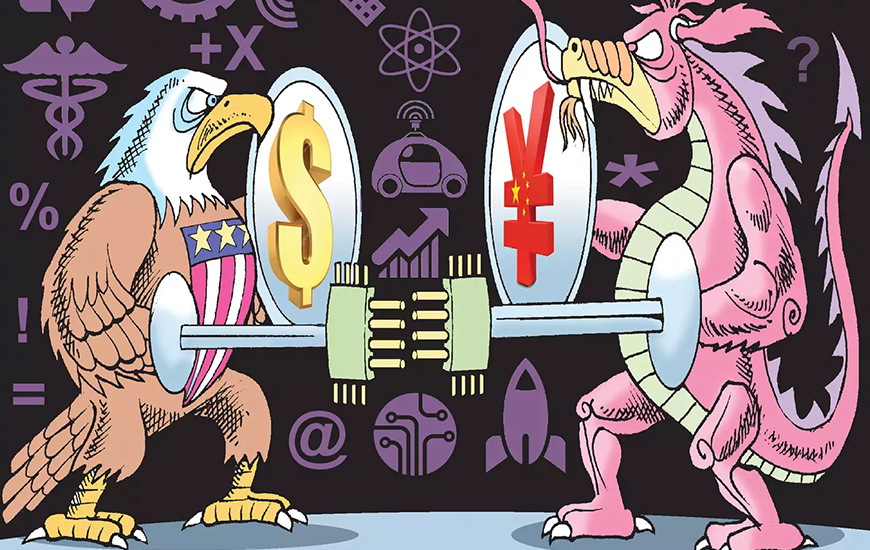
A full-blown trade war is on between the US and China, and we shouldn’t be surprised. The US has used tariffs before to protect its industries, with mixed results. Will the US be better off after imposing this latest round of tariffs? The Trump administration’s fixation on escalating these conventional trade war tactics misses the big picture: if the US government doesn’t start heavily investing in technology, with private firms following suit, tariffs aren’t going to matter. The US will have handed over global economic leadership to China, and it won’t be easy to get it back.
As global societies are propelled into the Second Machine Age, the battle for economic supremacy is fought at the digital frontlines for global leadership in artificial intelligence and machine learning methods. The US government itself acknowledged in its National Artificial Intelligence Research and Development Strategic Plan that China leads the US in terms of scientific publications in AI research. The Chinese government has taken an “all hands on deck” strategy in unveiling its 2030 plan to become the global AI superpower by officially declaring AI as a new engine of economic development. It has laid out a finely curated “three steps” game plan to create a $150 billion AI industry by 2030.
The harsh reality for the US is this: AI will add $16 trillion to the global GDP by 2030 of which China is projected to take almost half ($7 trillion) whereas US will have less than a quarter ($3.7 trillion). The not-so-secret sauce of economic prosperity has always been technology. As the 21st century unfolds, as machine and human brains entangle to become one, the dominant impact of technology investment on society is a “no brainer”.
The US owes much of its technology leadership to European technologies, to government’s investment in basic and applied research and risk capital. China is following in US footsteps, but at a much faster pace. Starting from the pro-market economic reforms in 1978 China has copied, improved and commercialised technologies developed in the US. For example, in the two recent breakthrough gene editing technologies invented in the US, China is either “neck and neck” in terms of research publications (CRISPR/Cas systems) or way ahead (TALENs).
Chinese giant Tencent, for example, founded its AI lab in 2016 and in the same year copied the ground breaking algorithms of AlphaGo (created by the startup DeepMind) that beat Lee Sedol, the world champion Go player. Now, Tencent has created its own Go programme called ‘Fine Art’ that defeated Ke Jie, the current top Go player in the world for the last three years, despite giving him a significant head start.
When Apple announced the release of iPhoneX, its signature product in several years touting its facial recognition technology, 450 million Chinese customers of Alipay were already using facial recognition to access their mobile digital accounts. In fact, China today sells to the US $57 billion more in advanced technology products (ATP) than what it buys from the US. Moreover, China is the single largest seller of ATP. 34% of US ATP imports in 2017 came from China; almost twice the share coming from Europe, 19%.
Though China’s real GDP per capita is about one-fifth that of the US its R&D spending, 2.1% of GDP, is close to the 2.8% of GDP in the US. The government strongly encourages entrepreneurship and claims that more than 15,000 new businesses register every day on average. China now hosts two out of the three most valuable startups in the world: Chinese Didi Chuxing ($56 billion) and Meituan-Dianping ($30 billion) follow US Uber ($63 billion).
While tariffs or other less visible protectionist measures might increase sales of some US technology in the short term they do little to spur investments in new technology, further aggravating the tendency for generalised lack of investment by US firms. Meanwhile, advanced technology firms in China would focus on tapping into the internal middle class market, projected to be three times as big as the US middle class, just as the US did post World War II.
At least for the foreseeable future the Chinese middle class is their core economic strength, and they are doing fine without the dominant presence of Google and Amazon, the two giants apparently shaping the rest of the global culture. The US historical playbook is no secret and emphasises technology as the key driver of economic success. China appropriated it and now seems to be following it more closely than its former users.
However, the fact still remains that state-owned enterprises in China are pervasive and not as profitable as non-state-owned firms. Moreover, China does not always enforce intellectual property rights, nor promote transparency or protect non-state shareholder interests. China still needs to build more global brand names and environmentally sustainable firms.
It is obvious that the next few years are “mission critical” for the US. Tariffs and other vagaries of politics will do little to improve the overall competitive position of US firms. In these turbulent times, these defensive play calling strategies are like choosing to play one-handed basketball. The real play to call is for the government to return to its pioneer roots, dig its heels in, and invest for the long term in frontier research in science, technology and entrepreneurship. For America to lead the way economically, it has to believe it can create the unimaginable by sticking to its playbook.




